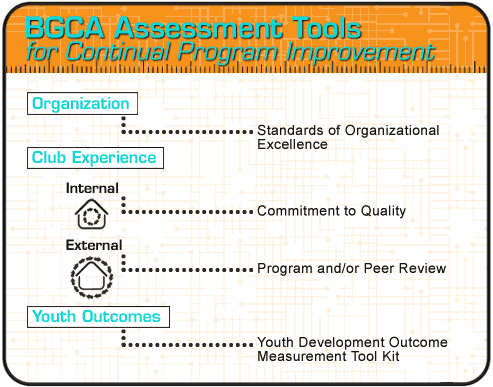|
|
|
BGCA offers a range of assessment tools that may be used in conjunction with the Youth Development Outcome Measurement Tool Kit to ensure that Clubs are developing and sustaining the highest level of quality possible in their organizations.
Just as the Tool Kit has been revamped, BGCA continues to create new tools and revise existing ones so that they complement each other and provide Clubs with an integrated framework for continually evaluating, planning and improving their service to young people. Several assessment tools currently help Clubs examine their effectiveness from various perspectives and on three levels:
- the operational excellence of the organization;
- the quality and effectiveness of the Club experience; and
- the developmental outcomes achieved for and by youth.

Level 1: The Organization
STANDARDS OF ORGANIZATIONAL EXCELLENCE (SOES)
At least every three years, all Club organizations participate in an assessment of their operational effectiveness using BGCA’s Standards of Organizational Excellence . Board presidents and chief professional officers of individual Clubs work with a BGCA regional service director, who facilitates and guides them through the self-assessment process. As Clubs evaluate all aspects of their organization – programming, resource development, board development, facilities management, operations, staffing, recruitment and retention – they focus on areas that can make the Club sustainable over time, identify aspects that need improvement and create a development plan for future growth.
Tool Kit survey data can be used to inform a Club organization’s SOE assessment ratings for programming, operations and staffing, or to inform action planning and staff training to address needs for improvement in these critical areas.
Level 2: The Club Experience
COMMITMENT TO QUALITY (CTQ)
An optional tool, Commitment to Quality is designed to help Clubs conduct an annual internal assessment of the quality of their programs and practices, addressing areas of need and maximizing their ability to serve young people. By measuring and tracking the quality of Club programming, Clubs can evaluate how well they are meeting the needs and interests of youth in the core program areas of character and leadership, education and career, health and life skills, the arts and sports, fitness and recreation. As staff and volunteers work together to evaluate the current level of Club programming, develop 12-month objectives and create action plans geared toward enhancement, they share the responsibility for meeting the Club’s objectives and making measurable improvements in the quality of the experience offered to young people.
The Tool Kit can be used in concert with Commitment to Quality. If member scores fall in the Room to Grow range for certain outcome indicators, Clubs can use Commitment to Quality to set program improvement goals in the appropriate areas.
PROGRAM REVIEW
The Program Review is an external assessment of the quality of Club programming and environment within a specific organization. It is an optional, voluntary tool that focuses on some of the same areas addressed by the SOEs and CTQ, but is based on observations and anecdotal information rather than quantitative measurement or tracking. A Program Review consultant works with Club staff to address questions about the organization’s ability to provide physical and psychological safety, its level of cleanliness and orderliness and the opportunities for members to have fun in both interest- and needs-based programs. The Program Review also assesses how well the Club is implementing BGCA’s strategic programming and Youth Development Strategy.
The Tool Kit can be used in conjunction with a Program Review. If Clubs are interested in positively affecting outcome indicators such as Club Benefits or Club Connections, Program Reviews can be used to to independently assess how well Clubs are creating an environment that supports fun, active use of our Youth Development Strategy, strategic programming and achievement of youth development outcomes.
PEER REVIEW
The Peer Review checklist is another optional, voluntary external assessment tool based on the Program Review. A Club can request that an outside observer from another Club organization visit its facility and quickly provide feedback on programs, facilities and environment using the Peer Review checklist. Peer Reviews can help Clubs identify the strengths of their current programs and facilities and areas to be strengthened. Peer Reviews are best conducted by seasoned Club staff who are experts in good programming from different Club organizations. Peer Reviews are not managed by BGCA. BGCA staff members at national headquarters and in the regional service centers are available, however, to provide technical assistance to Clubs that wish to employ the Peer Review tool.
The Peer Review Checklist can be used to obtain instant feedback on areas for improvement that may have a positive impact on member outcome indicator areas revealed by using the Tool Kit surveys.
Level 3: Youth Outcomes
YOUTH DEVELOPMENT OUTCOME MEASUREMENT TOOL KIT
Users who have put this revamped Web-based Tool Kit to work already know that it is faster, more user-friendly and offers greater reliability of the survey questions and outcome indicator scales. Both chief professional officers and youth development professionals can use this tool to gather data directly from the youth they serve about their general well-being and the degree to which they are acquiring the skills, competencies and attitudes defined in the Boys & Girls Club Movement’s Youth Development Outcomes.
Clubs that are committed to a continual process of assessing, improving and expanding their programming and services strategically employ several or all of these tools to as they strive to achieve their youth development mission and be the best possible resources in their communities for young people and their families.
|